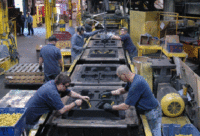Workplace ergonomics is getting a lot of attention nationwide in response to a sharp increase in incidents of repetitive strain injuries, such as carpal tunnel syndrome. For the affected employee, such injuries often mean repeated surgery, intractable pain and the inability to work. For the employer, ultimately, they mean higher costs.
Several factors increase the risk of musculoskeletal disorders and negatively affect productivity. These include work surfaces at the wrong height, uncomfortable chairs, shelves and bins that are too high or out of reach, and awkward hand tools.
A wealth of options is available to adjust the workspace to meet employees’ ergonomic needs, and employers can reap significant rewards on the bottom line by selecting the right ones. That’s because paying attention to ergonomics invariably improves productivity. Comfortable employees stay at their desks or workstations longer, and complete more work in a given shift.
Ergonomics is the science of designing a job to fit the worker, rather than physically forcing the worker’s body to fit the job. By adapting tasks, workstations, tools and equipment to fit the worker, ergonomics seeks to reduce physical stress on a worker’s body and prevent disabling work-related musculoskeletal disorders.
If work tasks and equipment do not include ergonomic principles in their design, workers may be exposed to undue physical stress from vibration, awkward postures, repetitive motion and heavy lifting.
By following these four simple steps, manufacturers can create a more ergonomic—and productive—assembly plant.
Step 1: Assess Risk Factors
The first step to correcting problems is to understand the key ergonomic risk factors and review work tasks in your assembly operation to see which ones apply. This can make a tremendous difference. Occupational safety professionals estimate that reducing physical stresses could eliminate as much as half the serious injuries that happen each year. Predicting what might go wrong and modifying tools and the work environment to make tasks safer for workers is the first step to reducing problems.
Table 1 lists these key risk factors and the injuries each may cause.
Step 2: Control Risk Factors
Engineering controls, administrative controls and personal equipment are the three key ways to control ergonomic risk factors. Examine each of these to see how they might be used to control the risks identified in Step 1.
Engineering controls to improve ergonomic risks include:
Changing the way parts and materials are transported.
Changing the process to reduce how workers are exposed to risk factors.
Moving parts around to make it easier for workers to reach them.
Changing workstation layout, tool design, or access and assembly sequence.
Of equal impact are administrative controls, or adjusting work practices and policies to reduce risk factors. Examples include rest breaks, job rotation or training to identify signs of ergonomic stress.
Finally, engineers should consider deploying personal equipment, including wrist supports, back belts or vibration attenuation gloves. However, it should be noted that, although personal equipment may reduce the duration, frequency or intensity of exposure to risk, their effectiveness in injury reduction is considered inconclusive by the National Institute for Occupational Safety and Health.
Step 3: Get the Right Equipment
With any task, selecting the right tool is crucial. The key is to understand the work process and employees’ safety needs. After identifying the likely risk factors in an operation, develop a safer work environment by carefully selecting the tools and workstations workers will use. Start the process by asking these questions:
Does the assembly process involve handling heavy, bulky or awkward products?
Is there a high product mix, with many changeovers per day?
Will workstations be integrated with material flow—with racks or conveyors, for example?
Is there frequent job rotation? Will employees from different shifts or departments be sharing a work area?
Will employees work alone, back-to-back or in teams?
Does a workstation need to include power tools, computer equipment, supplemental lighting or storage space?
Common issues include work surfaces that are the wrong size or at the wrong height; uncomfortable chairs; shelves and bins that are too high or out of reach; and awkward hand tools.
To counter these issues, it is important for employees to be able to rearrange workstation elements easily. Regardless of the physical characteristics or the tasks performed, employees should be able to adjust the height of work surfaces, shelves and chair seats to meet their unique needs.
Step 4: Apply Design Principles
Table 2 lists general workstation design principles, covering a range of considerations employers should use when designing workstations.
The most important principle to keep in mind is that work is handled most efficiently when kept within areas defined as “primary reach zones.” These are the horizontal and vertical areas that a worker can reach with minimal arm, head or trunk movement. Moving away from these primary zones requires more movement, and ultimately more time. Ergonomic workstations keep most work tasks focused within these reach zones—typically within a 24-inch radius of the worker’s body. Everything else should be considered storage.
To minimize stress and strain for seated employees, the workstation should be at the right height to support the particular task being performed. Precision work usually requires a higher work surface, while heavier work demands a lower work surface. Generally speaking, a 30.5-inch work surface height will accommodate 99.5 percent of all male and 99.9 percent of all female workers.
If different shifts will be using the same bench, or if different tasks will be performed on the same bench, consider an adjustable-height workstation. With such a bench, workers can adjust the bench height with the simple turn of a crank or with a motor drive. The work surface can move between approximately 27 and 38 inches. This would accommodate the height of the widest range of workers, from about 5 feet to 6 feet 8 inches.
Engineers will want to keep hand tools, small parts, nuts and bolts within easy reach. Engineers should also provide a comfortable and adjustable chair, a foot rest and proper lighting. A final consideration—and one that is becoming more important—is the location of computer monitors. Workers should have the ability to position monitors up or down to be at their eye level. With the rise of flat panel monitors, employers are finding swing arms a useful tool for positioning monitors to avoid eye strain. A negative-tilt keyboard tray is also recommended for reducing wrist strain.
Case in Point
Nonin Medical Inc. of Plymouth, MN, decided to install ergonomic workstations as part of a lean manufacturing project. The company, which makes pulse oximeters and other devices, wanted flexible workbenches that could be used by employees of different sizes. The company also wanted to improve lighting and give assemblers better access to tools and parts.
The company eventually chose Lista’s Arlink 8000 modular workstation, which is designed for quick assembly and reconfiguration. The workstations can be configured in a variety of heights and lengths to suit unique needs. The workstation’s Definite Positioning System makes it easy to relocate and adjust work surfaces, storage, shelving, lights, power beams and footrests, without requiring any extra tools.





